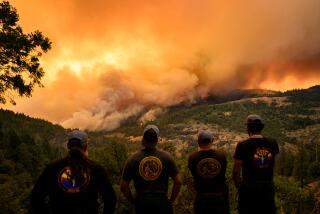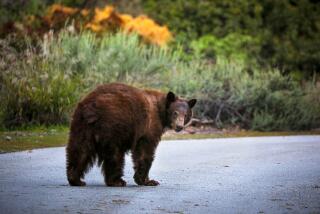Tule elk get rude reception from dairy farmers and ranchers

One of the largest tule elk herds in the state roams the canyons and foothills of a wildlife preserve about an hour’s drive north of metropolitan Los Angeles.
Reporting from BAKERSFIELD, Calif. — In a canyon about 90 miles north of Los Angeles, biologist Megan Lundin investigated evidence of a brutal struggle around the partially devoured carcass of a tule elk.
A trail of dark brown hair showed the 300-pound cow had been dragged several yards after it was attacked. Most of its hindquarters had been eaten, and there were puncture wounds in its neck.
“A big mountain lion took her down, which is great news,” said Lundin, elated by the kill in the Wind Wolves Preserve, about 10 miles west of Bakersfield.
Nineteen tule elk were transplanted to the preserve two decades ago as part of an effort to restore the ecological balance in its 99,000 acres of canyons, rolling grasslands and plateaus. Now, with 360 elk roaming the property, biologists are watching as ancient natural cycles are renewed in the San Emigdio Mountains.
But the thriving herd is making life miserable for cattle rancher Richard Snedden, who is pursuing legal remedies to have the 800-pound animals he calls “sorry varmints” eliminated. “They’re very destructive trespassers and a burden on our operations,” said Snedden, who leases about 800 acres from the preserve.
The dispute underlines a growing rift between conservationists who believe tule elk are essential to their vision of a truly wild California, and dairy farmers and ranchers who regard them as marauders prone to knocking down fences and competing with livestock for grass in drought-stressed pastures.
Caught in the middle is the state Department of Fish and Wildlife, which has jurisdiction over the only elk species endemic to California.
Once numbering about 500,000 in the San Joaquin Valley and coastal foothills, the tule elk population was reduced to two — a male and a female — by the 1870s because of unrestricted hunting and large-scale conversion of habitat to agriculture.
Today, largely because of state-sponsored captive breeding and reintroduction efforts, 4,300 tule elk live in 22 isolated herds throughout California. Plenty of habitat exists for additional tule elk, officials say, but social tolerance for them is scarce.
So the agency has quietly stopped expanding herds of the species, which is not threatened or endangered. Instead, the agency’s strategy is to respond to complaints by transplanting “excess elk” from one herd to another.
In 2006, the state relocated dozens of tule elk from the San Francisco Bay Area’s Concord Naval Weapons Station to make way for subdivisions. This year, dozens of “excess elk” were moved from a 750-acre pen in the San Luis National Wildlife Refuge near Merced, Calif., to Wind Wolves in Kern County.
“If we could find a spot to plunk down a few more tule elk, we’d do it,” said Eric Loft, chief of the state’s wildlife branch. “But there are fewer and fewer places where we can put them that there won’t be a conflict.”
Elk-human conflicts have become routine. Tule elk are feasting on grain fields and pastures in several counties, state officials said.
At the Point Reyes National Seashore, two dozen commercial dairy farmers and ranches are demanding that park officials rein in tule elk on leased land meant for livestock.
That kind of talk is disheartening to research scientists and tule elk experts who argue the state lacks the political will to grow the herds, or even complete a sorely needed comprehensive management plan for them.
“Bringing the tule elk back from the edge in a landscape shared by more than 30 million people was an incredible environmental success story — and now it’s a challenge,” said Joe Hobbs, the state’s tule elk recovery coordinator.
“A statewide management plan for tule elk is decades overdue, and I’m working on a draft plan right now,” Hobbs said. “The problem is this: It’s only me working on it.”
Steven Greco, a UC Davis biology professor, said scientists are concerned about the genetic viability of the species if it is dispersed into herds that do not intermingle. “Genetic bottlenecking among isolated herds can make them more vulnerable to disease,” Greco said.
Wind Wolves, a creation of the nonprofit Wildlands Conservancy, is negotiating with federal and state officials to take as many “excess elk” as possible from troubled preserves elsewhere. It’s goal: a herd of about 1,500 of the animals.
Air and ground observations suggest the preserve’s tule elk — some of them with radio collars — are faring well, browsing on rolling hills, defending breeding grounds and communicating in barks, grunts and screams known as bugling.
Changes in the preserve’s food webs are well underway. Coyotes, foxes, ravens, mice and beetles were dining on the rotting carcass of the elk within a day after it was brought down by a mountain lion. Barn owls were feasting on the mice. Birds, including loggerhead shrikes, were eating the beetles.
A few hundred yards away, a herd of 60 tule elk led by bulls with antlers reaching 3 feet long, grazed on a steep slope.







